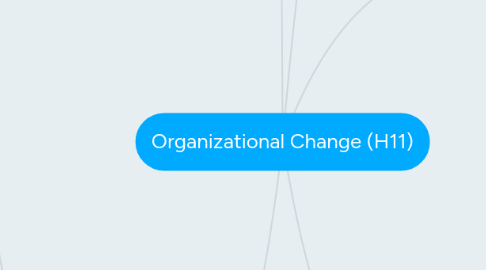
1. Population ecology theory
1.1. A theory that seeks to explain the factors that affect the rate at which new organizations are born in a population of existing organizations
1.2. The population of organizations are competing for the same set of resources in the environment
1.3. Environmental niches are particular sets of resources
1.4. Number of births
1.4.1. Population density is the number of organizations that can compete for the same resources in a particular environment
1.4.2. First mover advantages are the benefits from being an early entrant into a new environment
1.5. Two strategies to enhance survival
1.5.1. r-stategy
1.5.1.1. A strategy of entering a new envorinemt early
1.5.2. K-strategy
1.5.2.1. A strategy of entering an environment late, after other organizations have tested the water
1.5.3. Specialist strategy
1.5.3.1. Organizations that concentrate their skills to pursue a narrow range of resources in a single niche
1.5.4. Generalist strategy
1.5.4.1. Organizations that spread their skills thinly to compete for a broad range of resources in many niches
1.6. Natural selection
1.6.1. The process that ensures the survival of the organizations that have the skills and abilities that best fit with the environment
2. Institutional theory of organizational growth
2.1. Organizational growth is the life cycle stage in which organizations develop value creation skills and compentences that allow them to acquire additional resources
2.2. Institutional theory studies how organizations can increase their ability to grow and survive in a competitive environment by satisfying their stakeholders
2.3. Institutional environment is the set of values and norms in an environment that govern the behaviour of a population of organizations
2.4. Organizational isomorphism
2.4.1. This is the similarity among organizations in a population
2.4.2. 3 processes that explain why organizations become more alike
2.4.2.1. Coercive isomorphism
2.4.2.1.1. An organization adopts certain kinds of values and norms because its pressured to by other organizations/society in general
2.4.2.2. Mimetic isomorphism
2.4.2.2.1. When organizations intentionally imitate and copy one another to increase their legitimacy
2.4.2.3. Normative isomorphism
2.4.2.3.1. When organizations come to resemble one another over time because the indirectly adopt the norms and values of other organizations in the environment
2.4.2.4. Disadvantages of isomorphism
2.4.2.4.1. becoming outdated, low effectiveness, level of innovation declines
3. Organizational life cycle
3.1. A sequence of stages of growth and development through which organizations may pass
3.2. Organizational birth
3.2.1. Entrepreneurs are people who recognize and take advantage of opportunities to use their skills and competences to create value
3.2.2. The birth is the founding of an organization and is a dangerous stage associated with the greatest change of failure
3.2.3. Liability of newness are the dangerss associated with being the first in a new environment
4. Greiner's model of organizational growth
4.1. Stage 1: Growth through Creativity
4.1.1. Crisis of leadership
4.2. Stage 2: Growth through direction
4.2.1. Crisis of autonomy
4.3. Stage 3: Growth through delegation
4.3.1. Crisis of control
4.4. Stage 4: Growth through coordination
4.4.1. Crisis of red tape
4.5. Stage 5: Growth through collaboration
5. Organizational decline and death
5.1. Organizational decline is the stage that an organization enters when it fails to anticipate, recognize, avoid, neutralize, or adapt to external or internal pressures that threaten its long-term survival
5.2. Effectiveness and profitability
5.2.1. Profitability is a measurement of how well a company is making use of resources relative to its competitors
5.3. Organizational inertia
5.3.1. Are forces inside an organization that make it resistant to change
5.3.2. Problems
5.3.2.1. Risk aversion
5.3.2.2. The desire to maximize rewards
5.3.2.3. Overly bureaucratic culture
5.4. Changes in the Environment
5.5. Weitzel and Jonsson's model of organizational decline
5.5.1. Stage 1: blinded
5.5.2. Stage 2: inaction
5.5.3. Stage 3: faulty action
5.5.4. Stage 4: crisis
5.5.5. Stage 5: dissolution
